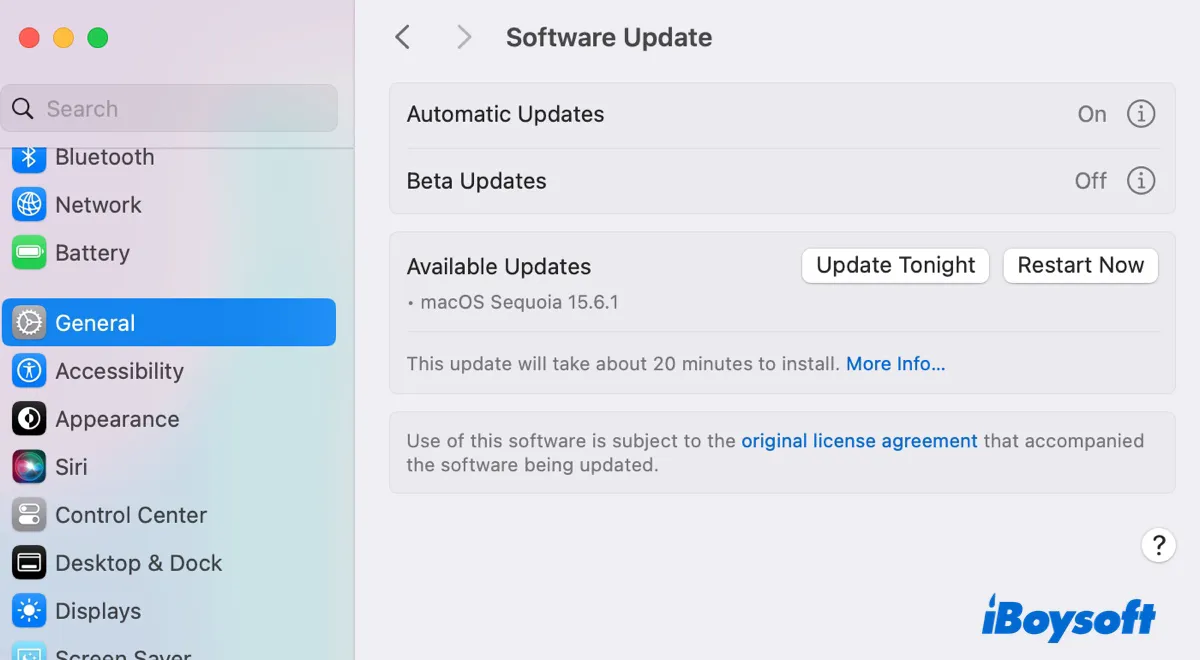Ready to harness the newest features and security for your Mac?
Whether you're updating or upgrading the system to the latest macOS 26 Tahoe, reinstalling an older version available to your Mac, or performing a clean install, it's essential to learn how to download and install macOS Tahoe or earlier.
In this comprehensive guide, we'll cover everything you need to know about downloading and installing macOS. It applies to all Mac OS versions from the most recent macOS 26 Tahoe, macOS Sequoia, and macOS Sonoma to the old Mac OS X releases.
- ﹥ If you want to update/upgrade your Mac, use Software Update, the Mac App Store, Terminal, or download the installer from the server.
- ﹥ If you want to clean install macOS, download the full installer from the App Store, Terminal, or the internet, then create a bootable USB installer. (Keep reading to clean install macOS Tahoe…)
- ﹥ If you want to reinstall macOS, download the macOS full installer and create a boot drive, or use macOS Recovery Mode.
- ﹥ If you want to downgrade macOS, download the macOS full installer and create a boot drive to erase your Mac and reinstall an earlier system.
Need Windows? Download Windows 11 | Windows 10 Download: Pro, Home, Enterprise & Education.
Check compatibility for macOS Tahoe or earlier
Before downloading and installing any macOS, it's important to check if it's compatible with your Mac, unless you're purposely installing it on an unsupported Mac (in which case, you should read about installing macOS on an old Mac). This can prevent download or installation errors during the process.
We'll list the Mac models compatible with the macOS versions that still receive updates from Apple (by the time of writing), including the newest macOS Tahoe 26, macOS Sequoia, macOS Sonoma, and macOS Ventura. To learn about the compatibility of earlier OS versions, check out the Mac OS Version History Guide.
- Compatible Macs for macOS Tahoe (2025):
- MacBook Air with Apple Silicon: (2020 and later)
MacBook Pro with Apple Silicon: (2020 and later)
MacBook Pro (13-inch, 2020, Four Thunderbolt 3 ports)
MacBook Pro (16-inch, 2019)
iMac (2020 and later)
Mac mini (2020 and later)
Mac Studio (2022 and later) - Compatible Macs for macOS Sequoia (2024):
- MacBook Air: 2020 and later
MacBook Pro: 2018 and later
iMac: 2019 and later
iMac Pro: 2017
Mac mini: 2018 and later
Mac Studio: 2022 and later
Mac Pro: 2019 and later - Compatible Macs for macOS Sonoma (2023):
- MacBook Air: 2018 and later
MacBook Pro: 2018 and later
iMac: 2019 and later
iMac Pro: 2017
Mac mini: 2018 and later
Mac Studio: 2022 and later
Mac Pro: 2019 and later - Compatible Macs for macOS Ventura (2022):
- MacBook: 2017 and later
MacBook Air: 2018 and later
MacBook Pro: 2017 and later
iMac: 2017 and later
iMac Pro: 2017
Mac mini: 2018 and later
Mac Studio: 2022 and later
Mac Pro: 2019 and later
Prepare more free space on your Mac
The second step is to prepare as much free space on your Mac as possible. Not having enough space is a common cause of macOS installation failure.
To download macOS, you'll need space for the download size, approximately 12-15 GB. After downloading, the installation process may take an additional 20-30 GB of free space to store temporary files, caches, and other necessary data. Then some features or applications may require more space to work properly, possibly 20-30 GB. So, you should maintain a minimum of 52-75 GB of free space to ensure optimal performance.
Get iBoysoft DiskGeeker for Mac to analyze your Mac's hard drive, identify large and unwanted files, and remove unnecessary items (e.g., caches, logs, preference files, unemptied trash, etc.).
Download and open the software, select your data volume, and choose Space Analyze to view all files on your Mac in descending order by size and remove unwanted data.
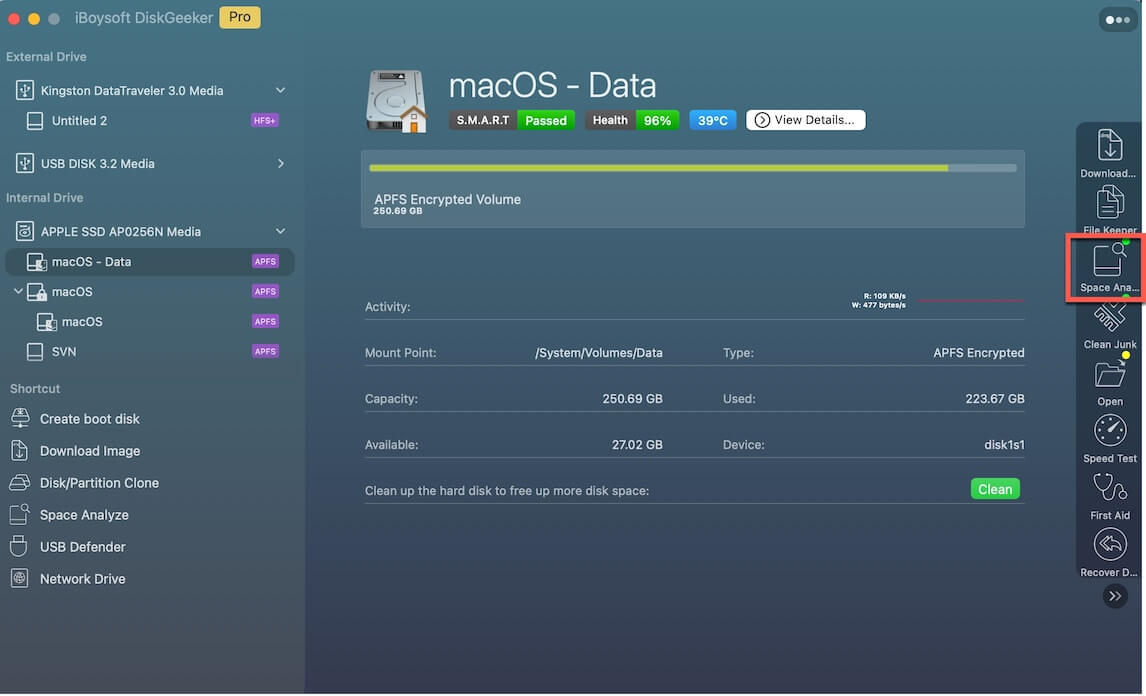
To remove junk files, select your data volume and choose Clean Junk.
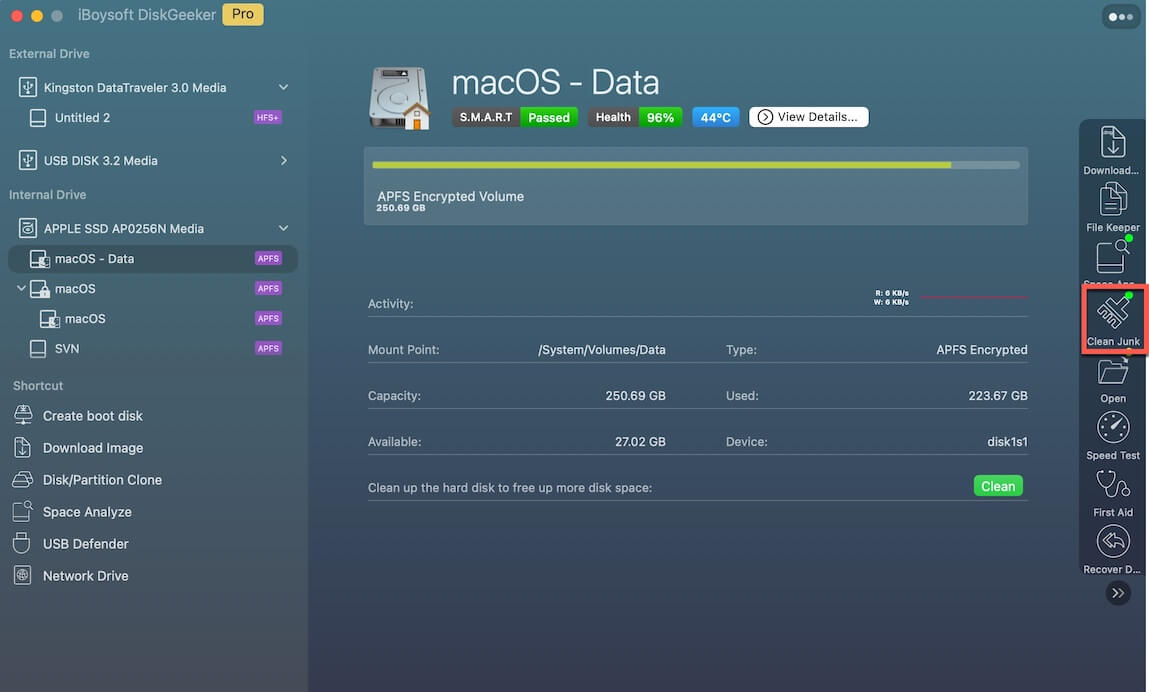
With everything in check, now is the time to download and install macOS Tahoe, Sequoia, Sonoma, Ventura, or an earlier version.
Tips: Keep your Mac plugged in when downloading and installing macOS! Besides, it's also recommended to back up your Mac with Time Machine before installing an update or a clean install.
Share the preparations with others!
Download & Install macOS Tahoe via Software Update
The most common way to download and update or upgrade macOS is through Software Update. It provides the latest version of macOS that's compatible with your Mac. However, it only offers an incremental update rather than a full installer. One advantage of using Software Update is that it uses less storage space.
To download and update macOS Tahoe, Sequoia, Sonoma, and Ventura, open System Settings > General > Software Update, then wait for the automatic check for updates. If an update is available, download it and click Upgrade Now to install it.

To download and update macOS Monterey, Big Sur, or earlier, open System Preferences > Software Update, then check for updates. If it finds a newer update, follow the onscreen instructions to download and install it.
Download & Install macOS Tahoe from Apple Server directly
If you'd rather download macOS Tahoe or earlier directly, click the link below:
Free Download macOS Tahoe Full Installer
Free Download Other macOS, OS X, and Mac OS X Full Installers
The links for newer OSes are PKG files from Apple's server, and for older OSes, they are likely DMG files from reliable resources. To install macOS, you must double-click on the file until it adds the app installer to the Applications folder. Then run the installer to finish the installation, or utilize it to make a bootable USB installer to perform a clean install.
Download and install macOS Tahoe from Terminal
Mac's command-line interface, Terminal, also allows you to update your Mac. You can run commands to download or install the full installer of a compatible macOS version easily. To do this, open Terminal from the Applications > Utilities folder, then type the commands based on your needs.
To download and install the latest macOS version automatically from Terminal:softwareupdate --fetch-full-installer --launch-installer
To download a specific macOS version in Terminal:
softwareupdate --fetch-full-installer --full-installer-version version-number
For instance, if you want to download macOS Tahoe, use: softwareupdate --fetch-full-installer --full-installer-version 26.0
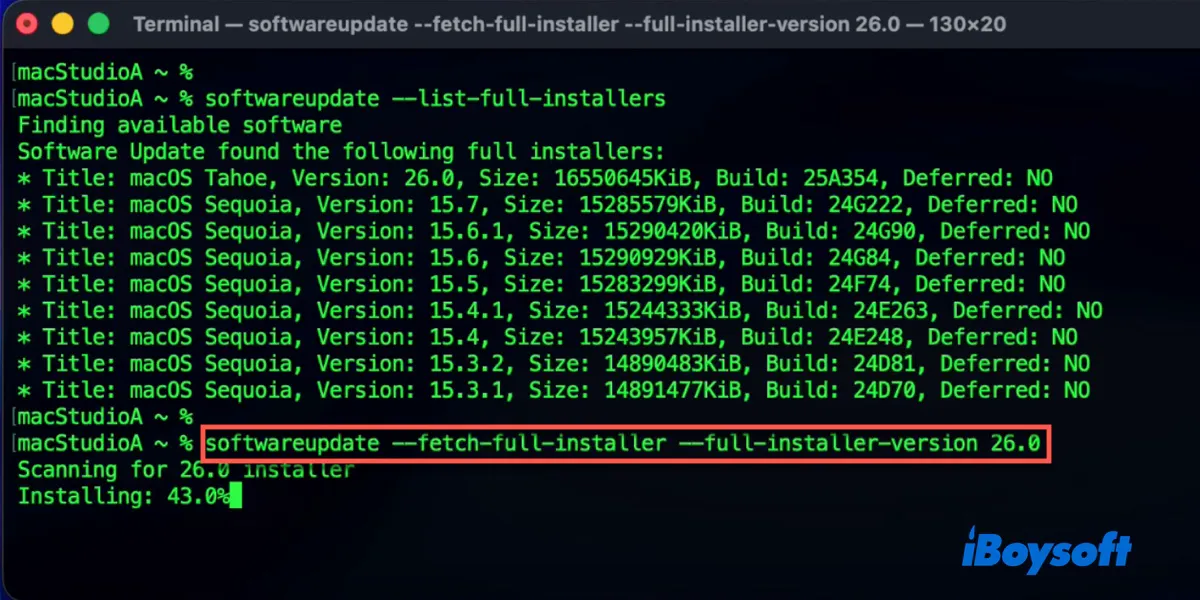
To learn more about updating macOS from Terminal, read: How to Update Mac from Terminal
Tips: In previous sections, we've covered four ways to download a Mac operating system and one simple way to update a Mac, which is to run the installer directly. In the sections below, we'll describe two more ways to install macOS to update a Mac or reinstall macOS.
Download & Install macOS via App Store
Tips: Apple has decided not to provide an App Store page for the macOS Tahoe full installer. Therefore, you can no longer download macOS Tahoe from the Mac App Store. To get the macOS Tahoe full installer, download it from Terminal or Apple's server.
Another method for downloading and updating macOS is from the Mac App Store. It can download the official full installer for macOS Sequoia to macOS Sierra if compatible. Then you can run the full installer to update your Mac or create a bootable USB installer to clean install it. Here's how:
1. Click the proper link below to open the Mac App Store. Or, search for your macOS version in the Mac App Store.
2. Click the Get button to begin downloading. It will open Software Update and validate your Mac's compatibility with the system. If they're incompatible, you'll get an error like "Update not found." If they are compatible, click the "Download Now" button. 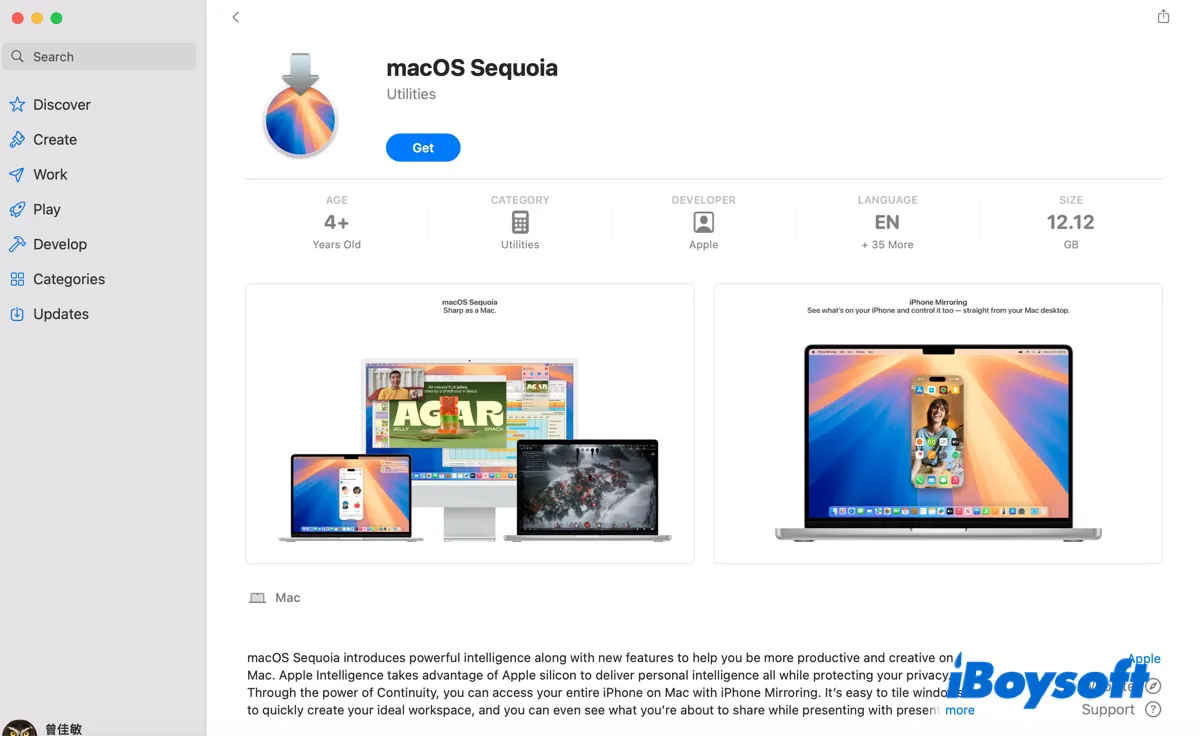
3. After the macOS full installer is complete, follow the instructions to install it.
Install macOS Tahoe with bootable USB installer
Creating a bootable USB installer to install macOS is also a popular choice. It can be used to upgrade or downgrade macOS, clean install macOS, install macOS on an unbootable Mac, or install macOS on multiple computers.
Here, I'll show you an easy way to create a bootable USB installer for macOS:
Step 1: Download and install iBoysoft DiskGeeker for Mac.
Step 2: Click Create boot disk from the left.
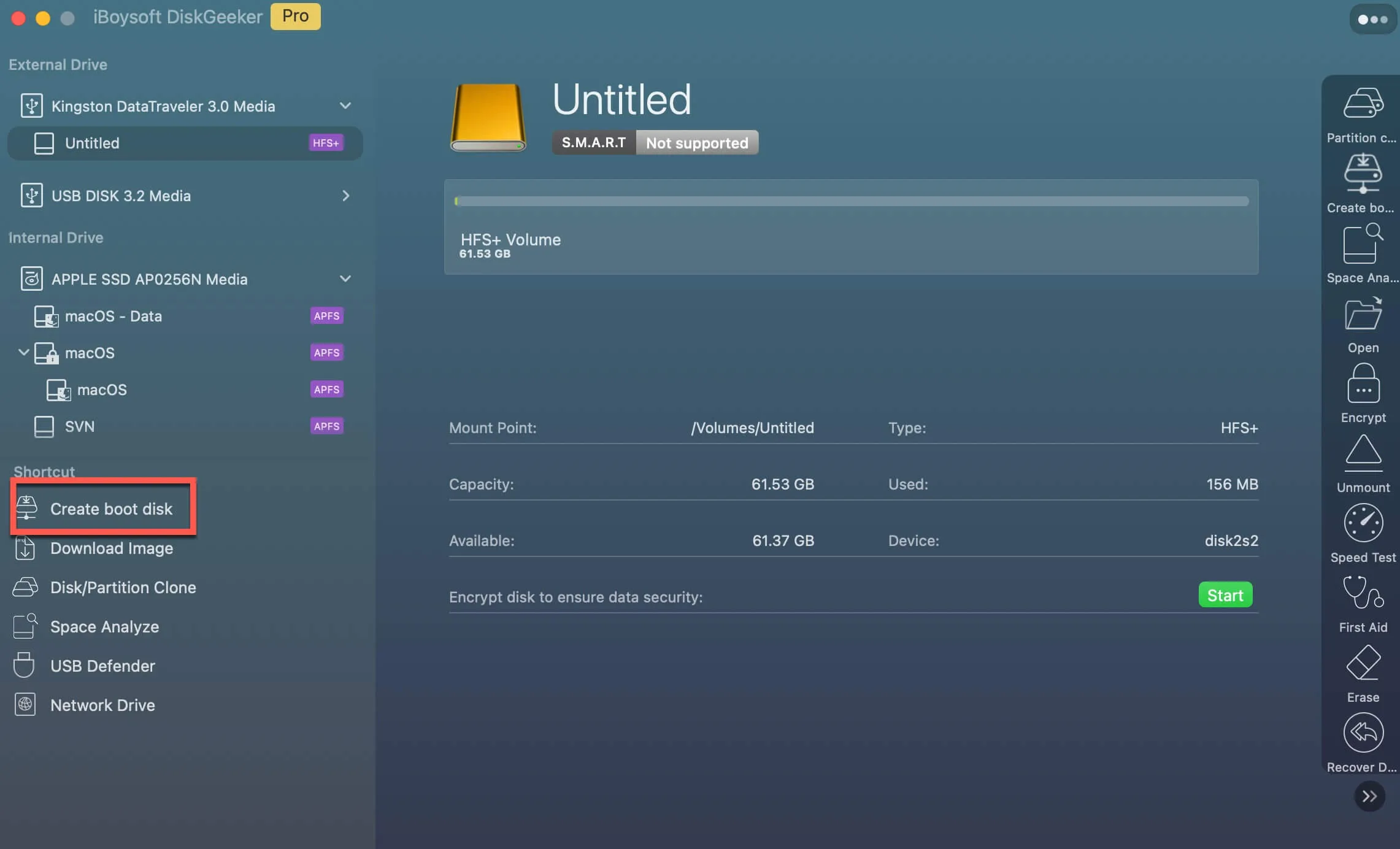
Step 3: Choose an external drive and click Select.

Step 4: Select a macOS version and click Create boot disk.
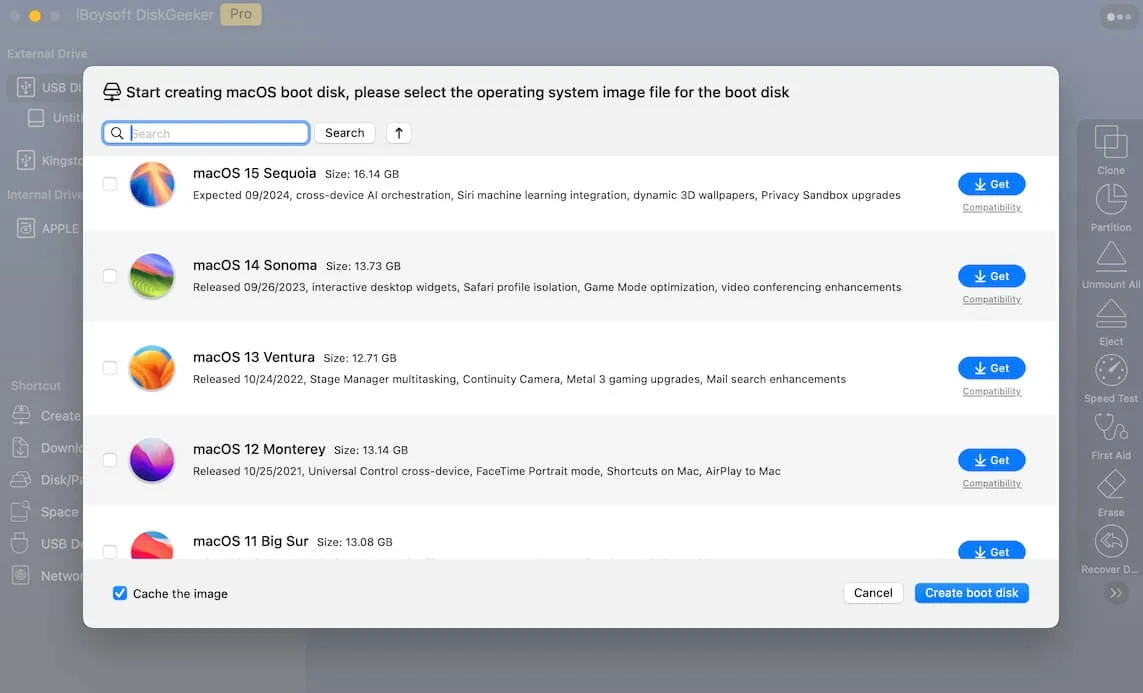
Step 5: Wait for the bootable installer to be created.
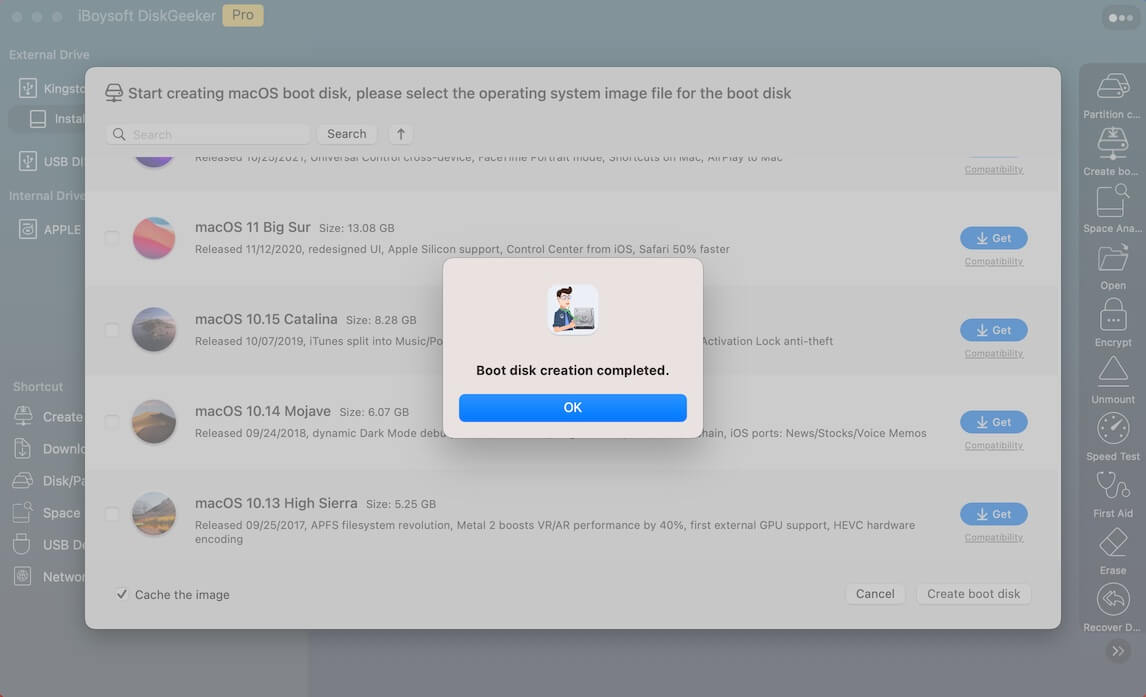
To manually create the bootable USB installer and boot from it to install macOS, continue reading: How to Install macOS from USB
Install macOS Tahoe from Recovery Mode
Recovery Mode also allows you to install macOS. It's especially useful for reinstalling macOS on an Apple Silicon Mac or updating or reinstalling macOS on an Intel-based Mac without downloading the installer first.
To reinstall macOS on an Apple Silicon Mac:
- Shut down your Mac.
- Press and hold the power button until the system volume and the Options button show up.
- Click Options > Continue.
- Select a volume if asked.
- Choose an administrator account and click Next.
- Enter your administrator password and click Continue.
- Choose "Reinstall macOS Tahoe" and click Next.
- Follow the instructions.
To update/reinstall/factory reset macOS on an Intel-based Mac:
- Turn off your Mac.
- Press the power button, then immediately hold down the appropriate keys.
Option-Command-R: Install the latest compatible macOS from the internet.
Command-R: Install the current version of the most recently installed macOS.
Shift-Option-Command-R: Install the version of macOS that originally came with your Mac or the closest available version. - Release the keys when the spinning globe/Apple logo appears.
- Choose your administrator account if asked.
- Enter your password and click Continue.
- Click "Reinstall macOS" and click Next.
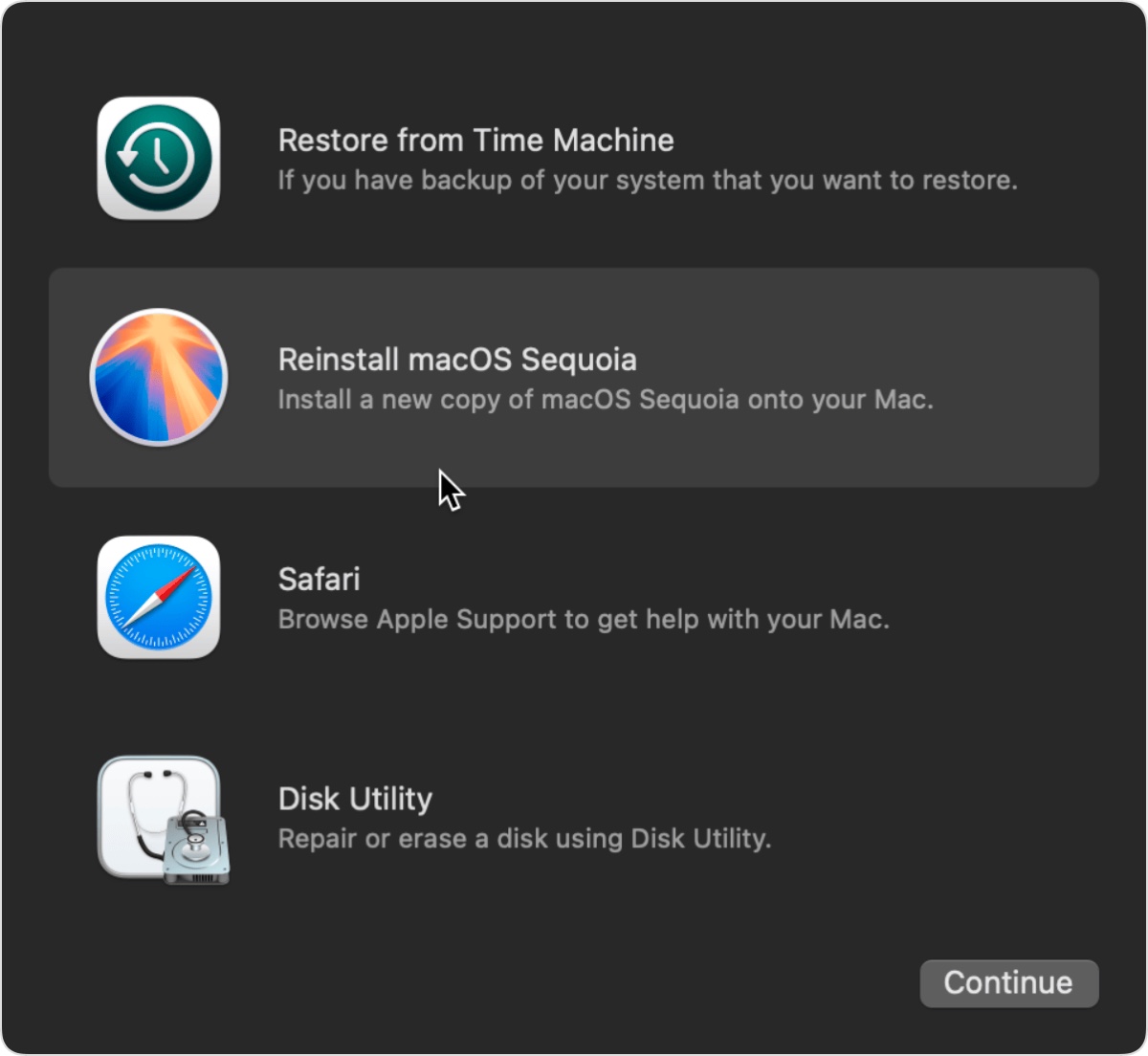
- Install macOS based on the on-screen instructions.
To erase and reinstall macOS: How to Wipe and Reinstall macOS from Scratch
Conclusion
To help you understand how to download and install macOS, we've gathered the details and shortcomings of each method in the following table:
| How to Download and Install macOS | Details | Disadvantages |
| Use Software Update | Download and install the latest compatible macOS update without taking too much space | 1. Not full installer but an incremental update 2. Only download the latest version available |
| Use Mac App Store | 1. Download and install a compatible macOS update through a full installer 2. Download compatible macOS full installer to create boot drive | Only download compatible versions & Only available to macOS Sequoia and earlier |
| Download and Install Directly | 1. Download an update and install it 2. Download any macOS full installer on supported or unsupported Mac 3. Download macOS full installer to create boot drive | Need extra clicking to reveal the app installer |
| Use Terminal | 1. Update macOS 3. Download compatible macOS full installer to create boot drive | Need to run Terminal commands |
| Create a Bootable USB Installer to install macOS | 1. Install or reinstall any compatible macOS, old or new 2. Install macOS for an unbootable Mac 3. Can be used repeatedly 4. Perform a clean install | More complex if manually creating |
| Use Recovery Mode to install macOS | 1. Reinstall, or update macOS on Intel-based Mac 2. Reinstall macOS on Apple Silicon Mac | 1. No dowloaded full installer 2. Can't update Apple Silicon Mac |
Share this guide on how to download and install macOS!
FAQs about how to download and install macOS
- QCan I install macOS for free?
-
A
Yes, macOS installation doesn't have any cost.
- QHow do you wipe and install macOS?
-
A
To wipe and install macOS, first boot into macOS Recovery, then open Disk Utility to format your internal hard drive. After that, click 'Reinstall macOS' to complete the installation.
